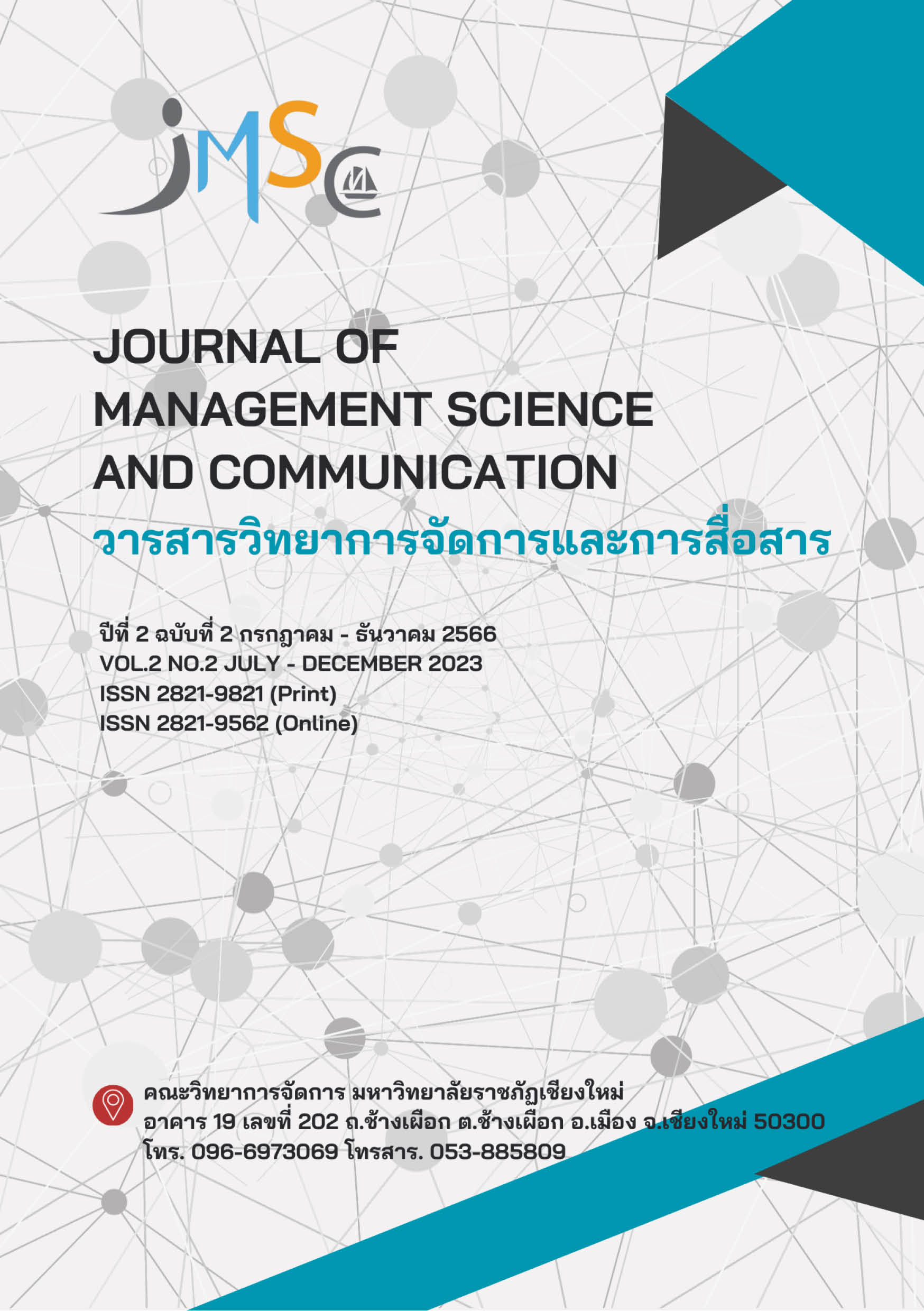Factors Influencing the Decision to Embrace K-pop Culture Among Teenagers and Working Adults In Chiang Mai Province
Main Article Content
Abstract
The objectives of this research were 1) to study the K-Pop culture exposure behaviors of adolescents and working people in the area of Chiang Mai Province, 2) to study the decision to accept the K-Pop culture of teenagers and working people in the area of Chiang Mai Province, 3) to study and compare demographic characteristics with the behavior of exposure to K-Pop culture of teenagers and working people in the area of Chiang Mai, and 4) to study the factors influencing the decision to accept K-Pop culture among adolescents and working people in the area of Chiang Mai Province. This research is quantitative research by survey research. The researcher collects questionnaires from a sample of adolescents and working people in Chiang Mai Province using a multistage random sampling method, totaling 400 people. The results showed that, firstly, most of the samples have a behavior of frequency exposure to news about K-Pop 1-3 days/week, 55.80% have hours of watching K-Pop news less than 2 hours per day % 47.00 52.80% use Facebook to follow K-Pop news and 64.50% follow K-Pop news through smartphones. Then, the mean and standard deviation of K-Pop culture acceptance decisions among adolescents and working adults in the area of Chiang Mai Province, the mean were included at the highest level (x̄ = 4.28, S.D.=0.60). Then, different demographics of teenagers and working people have different exposure behaviors to K-Pop news. Finally, Income, gender, age, and satisfaction with following K-Pop news affect the decision to choose K-Pop culture by 14.70 percent.
Downloads
Article Details

This work is licensed under a Creative Commons Attribution-NonCommercial-NoDerivatives 4.0 International License.
References
กมลชนก แก้วประทุม. (2555). พฤติกรรมการบริโภคเพลงเกาหลีของวัยรุ่นไทย. คณะอักษรศาสตร์ มหาวิทยาลัยศิลปากร. http://isas.arts.su.ac.th/wp-content/uploads/2555/social/social-2555-10.pdf
กาญจนา แก้วเทพ. (2555). สื่อที่ใช่ ของใครที่ชอบ. กรุงเทพฯ: ห้างหุ้นส่วนจำกัดภาพพิมพ์.
กาญจนา แก้วเทพ และนิคม ชัยขุนพล. (2555). คู่มือสื่อใหม่ศึกษา. กรุงเทพมหานคร: ภาพพิมพ์.
ชนิภรณ์ แก้วเนิน ณัฐนรี สมิตร และอรรภเวทย์ พฤกษ์สถาพร. (2563). พฤติกรรมการรับรู้ และทัศนคติของผู้บริโภคต่อสินค้าและการใช้บริการตามกระแสเกาหลีนิยม. วารสารวิทยาลัยดุสิตธานี. 14 (3). 277-294.
ชุติมา ชุณหกาญจน์. (2550). พฤติกรรมการเลียนแบบวัฒนธรรมของวัยรุ่นไทยจากสื่อบันเทิงเกาหลี. [วิทยานิพนธ์ปริญญามหาบัณฑิต, จุฬาลงกรณ์
มหาวิทยาลัย]. https://doi.nrct.go.th/ListDoi/listDetail?Resolve_DOI=10.14457/CU.the.2007.1022
ชานันต์ รัตนโชติ. (2552). ประโยชน์ในการรับข่าวสารจากหนังสือพิมพ์ออนไลน์ ของประชาชนในกรุงเทพมหานคร. [วิทยานิพนธ์ปริญญามหาบัณฑิต, มหาวิทยาลัยรามคําแหง]. https://dric.nrct.go.th/Search/SearchDetail/222560
จุติมาศ เกลี้ยงเกลา. (2556). การศึกษาภาพลักษณ์ของกลุ่มศิลปินนักร้องเกาหลีใต้ผ่านสื่อใหม่และพฤติกรรมแฟนคลับ. การประชุมทางวิชาการของมหาวิทยาลัยเกษตรศาสตร์ ครั้งที่ 51 (น.421-428). คณะมนุษยศาสตร์ มหาวิทยาลัยเกษตรศาสตร์. https://kukrdb.lib.ku.ac.th/proceedings/index.php?/KUCON/search_detail/result/13475
ณิชชา ยงกิจเจริญ. (2558). การเปิดรับข่าวสาร ทัศนคติ และแนวโน้มพฤติกรรมที่มีต่อศิลปินวง EXO ของกลุ่มแฟนคลับ EXO-L. [วิทยานิพนธ์ปริญญามหาบัณฑิต, มหาวิทยาลัยธรรมศาสตร์]. http://203.131.210.100/ejournal/wp-content/uploads/2016/09/JCIS59066.pdf
ปฏิภาณ หุตะโชค. (2556). กระบวนการแลกเปลี่ยนและการรับรู้วัฒนธรรมเกาหลีผ่านคลิปวีดีโอเพลงเกาหลีทางสื่อเว็บไซต์ของกลุ่มวัยรุ่นไทย. [วิทยานิพนธ์ปริญญาบัณฑิต, มหาวิทยาลัยธุรกิจบัณฑิตย์]. https://libdoc.dpu.ac.th/thesis/Patiparn.Hut.pdf
พีระ จิรโสภณ. (2541). หลักและทฤษฎีการสื่อสารมวลชน. นนทบุรี: มหาวิทยาลัยสุโขทัยธรรมาธิราช.
วรนุช ตันติวิทิตพงศ์. (2551). พฤติกรรมความคลั่งไคล้ศิลปินนักร้องเกาหลีของวัยรุ่นไทย. [วิทยานิพนธ์ปริญญามหาบัณฑิต, จุฬาลงกรณ์มหาวิทยาลัย]. https://doi.nrct.go.th/ListDoi/listDetail?Resolve_DOI=10.14457/CU.the.2008.1313
วิศรุต สินพงศพร. (2563). กลยุทธ์ K-POP สร้างชาติเกาหลี ครองโลกด้วยวงการบันเทิง. สำนักข่าวเวิร์คพอยท์ทูเดย์. https://workpointtoday.com/workpointtoday-says-hello
สถิติจำนวนประชากร พื้นที่จังหวัดเชียงใหม่. (2566). จำนวนประชากรในจังหวัดเชียงใหม่. https://stat.bora.dopa.go.th/stat/statnew/statMONTH/statmonth/#/displayData
สิน พันธุ์พินิจ. (2554). เทคนิคการวิจัยทางสังคมศาสตร์. กรุงเทพฯ : วิทยพัฒน์.
เสรี วงศ์มณฑา. (2552). กลยุทธ์การตลาด : การวางแผนการตลาด. กรุงเทพฯ: ธีระฟิล์มและไซเท็กซ์.
ศิริวรรณ เสรีรัตน์และคณะ. (2552). การบริหารการตลาดยุคใหม่. (ฉบับปรับปรุงใหม่). กรุงเทพฯ: บริษัทธรรมสาร จำกัด.
อริญชัย วีรดุษฎีนนท์. (2564). วัฒนธรรมไอดอลในสังคมไทย. นิตยสารจีคิวไทยแลนด์.https://www.gqthailand.com/views/article/the-idol-culture-phenomenon
อัษฎายุธ สุนทรศารทูล. (2547). ปัจจัยที่มีผลต่อการตัดสินใจเช่าใช้วงจรระบบดิจิตอลของบริษัท ทศท คอร์ปอเรชั่น จำกัด (มหาชน) ของลูกค้าประเภทธนาคาร. [วิทยานิพนธ์ปริญญามหาบัณฑิต, มหาวิทยาลัยราชภัฏพระนคร. https://doi.nrct.go.th/ListDoi/listDetail?Resolve_DOI=10.14457/PNRU.the.2004.116
Charies k.Atkin. (1973). Instrumental ๊Utilities and Information Seeking. In New Models for Mass Communication Research, Edited by P. Clarke, 205-242. Beverly Hills, CA: Sage.
DeFleur. (1989). Theories of Mass Communication. New York: Longman.
Kanya, S. (2009). General Psychology. Bangkok: Bamrungsann.


